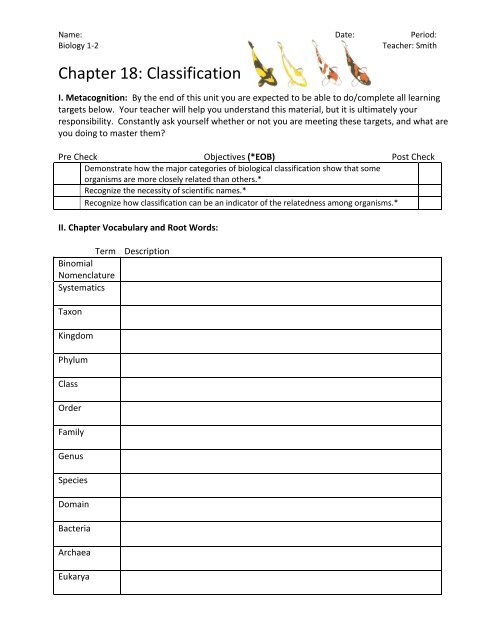Chapter 18: Classification
Chapter 18: Classification Chapter 18: Classification
Name: Date: Period:Biology 1-2Teacher: SmithChapter 18: ClassificationI. Metacognition: By the end of this unit you are expected to be able to do/complete all learningtargets below. Your teacher will help you understand this material, but it is ultimately yourresponsibility. Constantly ask yourself whether or not you are meeting these targets, and what areyou doing to master them?Pre Check Objectives (*EOB) Post CheckDemonstrate how the major categories of biological classification show that someorganisms are more closely related than others.*Recognize the necessity of scientific names.*Recognize how classification can be an indicator of the relatedness among organisms.*II. Chapter Vocabulary and Root Words:Term DescriptionBinomialNomenclatureSystematicsTaxonKingdomPhylumClassOrderFamilyGenusSpeciesDomainBacteriaArchaeaEukarya
- Page 2 and 3: Name: Date: Period:Biology 1-2Teach
- Page 6 and 7: Name: Date: Period:Biology 1-2Teach
- Page 8: Name: Date: Period:Biology 1-2Teach
Name: Date: Period:Biology 1-2Teacher: Smith<strong>Chapter</strong> <strong>18</strong>: <strong>Classification</strong>I. Metacognition: By the end of this unit you are expected to be able to do/complete all learningtargets below. Your teacher will help you understand this material, but it is ultimately yourresponsibility. Constantly ask yourself whether or not you are meeting these targets, and what areyou doing to master them?Pre Check Objectives (*EOB) Post CheckDemonstrate how the major categories of biological classification show that someorganisms are more closely related than others.*Recognize the necessity of scientific names.*Recognize how classification can be an indicator of the relatedness among organisms.*II. <strong>Chapter</strong> Vocabulary and Root Words:Term DescriptionBinomialNomenclatureSystematicsTaxonKingdomPhylumClassOrderFamilyGenusSpeciesDomainBacteriaArchaeaEukarya
Name: Date: Period:Biology 1-2Teacher: SmithProkayroteEukaryoteIII. Vocabulary Building:Due Date: __________________How am I going to learn this vocabulary (select one or come up with your own idea that is teacherapproved)?⃝ Make flashcards of all vocabulary terms and definitions.⃝ Make a flip chart including all vocabulary terms and definitions.⃝ Make flash cards of all vocabulary terms and a scientific diagram representing the term.⃝ Other Ideas (teacher approved)? ____________________________________________IV. Guided Reading Section Questions (*EOB):Section <strong>18</strong>.1 p.508-515: Finding Order in Diversity1. Why do scientists classify things?*_____________________________________________________________________________________________________________________________________________________________________________________________________2. What is the goal of binomial nomenclature? __________________________________________________________________________________________________________________3. In the 1730s, what Swedish botanist developed binomial nomenclature? __________________________________________________________________________________________4. What is the goal of systematics? ___________________________________________________________________________________________________________________________5. Why is a dichotomous key useful for identifying an organism? __________________________________________________________________________________________________6. How did Linnaeus group species into larger taxa? _________________________________________________________________________________________________________________________________________________________________________________________
Name: Date: Period:Biology 1-2Teacher: Smith7. Complete the graphic organizer.*A usefulscientific name8. List the main levels of organizationon the diagram to the right. *9. Which level encompasses thegreatest diversity of organisms? *_________________The least diversity of organisms? *_________________Hint: King Phillip Came Over For Good Spagetti.*10. Why can common names of organisms cause problems for scientists?* ____________________________________________________________________________________________11. In which group of organisms are the members more closely associated-all of the organismsin the same kingdom or all of the organisms in the same order? Explain your answer.*______________________________________________________________________________________________________________________________________________________12. What do scientists mean when they say that species is the only “natural” rank inclassification? *_________________________________________________________________________________________________________________________________________
Name: Date: Period:Biology 1-2Teacher: Smith11. According to the figure, which species ismost closely related to red pandas?________________________________12. Although giant pandas and raccoonsshare some similarities, they are indifferent clades. What type of evidencedo you think was used to construct thisdiagram?________________________________________________________________________________________________13. Biologists had previously classified giant pandas together with raccoons & red pandas. Whatdid DNA analysis reveal about giant pandas and bears?_________________________________________________________________________________________________________________________________________________________________________________________________________________________________Section <strong>18</strong>.3 p. 523-530: Building the Tree of Life1. Explain what the tree of life represents. _________________________________________________________________________________________________________________________________________________________________________________________________2. What are the six kingdoms of life as they are now identified? Complete the concept map.The Six-KingdomSystemIncludesAnimalia
Name: Date: Period:Biology 1-2Teacher: Smith3. Why did systematics establish the domain? ________________________________________________________________________________________________________________________________________________________________________________________________________________________________________________________________________4. Why did scientists place bacteria in their own kingdom, the Monera?_________________________________________________________________________________________________________________________________________________________________________________________________________________________________5. What two kingdoms was kingdom Monera separated into?________6. What are the three domains of life?_____________________ ____________________ _______________________7. Why are there quotes used when describing the kingdom “Protista”? _____________________________________________________________________________________________8. Do you think that tree of life cladogram will alays stay the same as it is in Figure <strong>18</strong>-<strong>18</strong> onpages 526-527? Explain your answer. __________________________________________________________________________________________________________________________________________________________________________________________________
Name: Date: Period:Biology 1-2Teacher: Smith9. Complete the chart below.<strong>Classification</strong> of Living ThingsDomain Kingdom ExamplesEubacteriaSalmonella typhimuriumArchaeaSulfolobus archaea“Protista”mushrooms, yeastsPlantaeSponges, worms, insects,fishes, mammalsMatch the kingdom with the description that applies to members of that kingdom.KingdomDescription10. “Protista” A. They feed on dead or decaying organic matter.11. Fungi B. They have no cell walls and they move about.12. Plantae C. They are a “catchall” group of eukaryotes.13. Animalia D. They include mosses and ferns.



